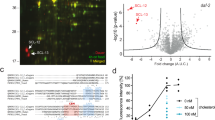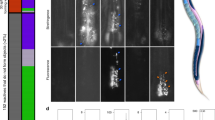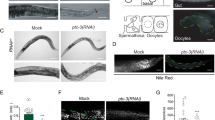Abstract
Cholesterol is a structural component of animal membranes that influences fluidity, permeability and formation of lipid microdomains. It is also a precursor to signalling molecules, including mammalian steroid hormones and insect ecdysones. The nematode Caenorhabditis elegans requires too little cholesterol for it to have a major role in membrane structure. Instead, its most probable signalling functions are to control molting and induce a specialized non-feeding larval stage, although no cholesterol-derived signalling molecule has yet been identified for these or any other functions.
This is a preview of subscription content, access via your institution
Access options
Subscribe to this journal
Receive 12 print issues and online access
$209.00 per year
only $17.42 per issue
Buy this article
- Purchase on Springer Link
- Instant access to full article PDF
Prices may be subject to local taxes which are calculated during checkout


Similar content being viewed by others
References
Haines, T.H. Do sterols reduce proton and sodium leaks through lipid bilayers? Prog. Lipid Res. 40, 299–324 (2001).
Simons, K. & Toomre, D. Lipid rafts and signal transduction. Nature Rev. Mol. Cell Biol. 1, 31–39 (2000).
Mann, R.K. & Beachy, P.A. Cholesterol modification of proteins. Biochim. Biophys. Acta 1529, 188–202 (2000).
Ashrafi, K. et al. Genome-wide RNAi analysis of Caenorhabditis elegans fat regulatory genes. Nature 421, 268–272 (2003).
McKay, R.M., McKay, J.P., Avery, L. & Graff, J.M. C. elegans: a model for exploring the genetics of fat storage. Dev. Cell 4, 131–142 (2003).
Hieb, W.F. & Rothstein, M. Sterol requirement for reproduction of a free-living nematode. Science 160, 778–780 (1968).
Chitwood, D.J. Biochemistry and function of nematode steroids. Crit. Rev. Biochem. Mol. Biol. 34, 273–284 (1999).
Chitwood, D.J., Lusby, W.R., Lozano, R., Thompson, M.J. & Svoboda, J.A. Novel nuclear methylation of sterols by the nematode Caenorhabditis elegans. Steroids 42, 311–319 (1983).
Sluder, A.E., Mathews, S.W., Hough, D., Yin, V.P. & Maina, C.V. The nuclear receptor superfamily has undergone extensive proliferation and diversification in nematodes. Genome Res. 9, 103–120 (1999).
Brenner, S. The genetics of Caenorhabditis elegans. Genetics 77, 71–94 (1974).
Yochem, J., Tuck, S., Greenwald, I. & Han, M. A gp330/megalin-related protein is required in the major epidermis of Caenorhabditis elegans for completion of molting. Development 126, 597–606 (1999).
Shim, Y.H., Chun, J.H., Lee, E.Y. & Paik, Y.K. Role of cholesterol in germ-line development of Caenorhabditis elegans. Mol. Reprod. Dev. 61, 358–366 (2002).
Crowder, C.M., Westover, E.J., Kumar, A.S., Ostlund, R.E., Jr & Covey, D.F. Enantiospecificity of cholesterol function in vivo. J. Biol. Chem. 276, 44369–44372 (2001).
Merris, M. et al. Sterol effects and sites of sterol accumulation in Caenorhabditis elegans: developmental requirement for 4α-methyl sterols. J. Lipid Res. 44, 172–181 (2003).
Chitwood, D.J., Lusby, W.R., Lozano, R., Thompson, M.J. & Svoboda, J.A. Sterol metabolism in the nematode Caenorhabdities elegans. Lipids 19, 500–505 (1984).
Korlach, J., Schwille, P., Webb, W.W. & Feigenson, G.W. Characterization of lipid bilayer phases by confocal microscopy and fluorescence correlation spectroscopy. Proc. Natl Acad. Sci. USA 96, 8461–8466 (1999).
Kahya, N., Scherfeld, D., Bacia, K., Poolman, B. & Schwille, P. Probing lipid mobility of raft-exhibiting model membranes by fluorescence correlation spectroscopy. J. Biol. Chem. DOI:10.1074/jbc.M302969200 (2003).
Matyash, V. et al. Distribution and transport of cholesterol in Caenorhabditis elegans. Mol. Biol. Cell 12, 1725–1736 (2001).
Scheel, J., Srinivasan, J., Honnert, U., Henske, A. & Kurzchalia, T.V. Involvement of caveolin-1 in meiotic cell-cycle progression in Caenorhabditis elegans. Nature Cell Biol. 1, 127–129 (1999).
Silberkang, M., Havel, C.M., Friend, D.S., McCarthy, B.J. & Watson, J.A. Isoprene synthesis in isolated embryonic Drosophila cells. I. Sterol-deficient eukaryotic cells. J. Biol. Chem. 258, 8503–8511 (1983).
Seegmiller, A.C. et al. The SREBP pathway in Drosophila: regulation by palmitate, not sterols. Dev. Cell 2, 229–238 (2002).
Dobrosotskaya, I.Y., Seegmiller, A.C., Brown, M.S., Goldstein, J.L. & Rawson, R.B. Regulation of SREBP processing and membrane lipid production by phospholipids in Drosophila. Science 296, 879–883 (2002).
Baker, M.E. Is vitellogenin an ancestor of apolipoprotein B-100 of human low-density lipoprotein and human lipoprotein lipase? Biochem. J. 255, 1057–1060 (1988).
Grant, B. & Hirsh, D. Receptor-mediated endocytosis in the Caenorhabditis elegans oocyte. Mol. Biol. Cell 10, 4311–4326 (1999).
Nelson, D.R. Metazoan cytochrome P450 evolution. Comp. Biochem. Physiol. C Pharmacol. Toxicol. Endocrinol. 121, 15–22 (1998).
Aspock, G., Kagoshima, H., Niklaus, G. & Burglin, T.R. Caenorhabditis elegans has scores of hedgehog-related genes: sequence and expression analysis. Genome Res. 9, 909–923 (1999).
Kamath, R.S. et al. Systematic functional analysis of the Caenorhabditis elegans genome using RNAi. Nature 421, 231–237 (2003).
Riddle, D.L. & Albert, P.S. in C. elegans II (eds Riddle, D.L., Blumenthal, T., Meyer, J.B. & Priess, J.R.) 739–768 (Cold Spring Harbor Laboratory Press, 1997).
Gerisch, B., Weitzel, C., Kober-Eisermann, C., Rottiers, V. & Antebi, A. A hormonal signaling pathway influencing C. elegans metabolism, reproductive development, and life span. Dev. Cell 1, 841–851 (2001).
Jia, K., Albert, P.S. & Riddle, D.L. DAF-9, a cytochrome P450 regulating C. elegans larval development and adult longevity. Development 129, 221–231 (2002).
Antebi, A., Culotti, J.G. & Hedgecock, E.M. daf-12 regulates developmental age and the dauer alternative in Caenorhabditis elegans. Development 125, 1191–1205 (1998).
Antebi, A., Yeh, W.H., Tait, D., Hedgecock, E.M. & Riddle, D.L. daf-12 encodes a nuclear receptor that regulates the dauer diapause and developmental age in C. elegans. Genes Dev. 14, 1512–1527 (2000).
Sym, M., Basson, M. & Johnson, C. A model for niemann-pick type C disease in the nematode Caenorhabditis elegans. Curr. Biol. 10, 527–530 (2000).
Kostrouchova, M., Krause, M., Kostrouch, Z. & Rall, J.E. CHR3: a Caenorhabditis elegans orphan nuclear hormone receptor required for proper epidermal development and molting. Development 125, 1617–1626 (1998).
Kostrouchova, M., Krause, M., Kostrouch, Z. & Rall, J.E. Nuclear hormone receptor CHR3 is a critical regulator of all four larval molts of the nematode Caenorhabditis elegans. Proc. Natl Acad. Sci. USA 98, 7360–7365 (2001).
Crossgrove, K., Laudet, V. & Maina, C.V. Dirofilaria immitis encodes Di-nhr-7, a putative orthologue of the Drosophila ecdysone-regulated E78 gene. Mol. Biochem. Parasitol. 119, 169–177 (2002).
Willnow, T.E., Nykjaer, A. & Herz, J. Lipoprotein receptors: new roles for ancient proteins. Nature Cell Biol. 1, E157–E162 (1999).
Acknowledgements
We thank members of the T.V.K. lab and C. Thiele (Max Planck Institute for Molecular Cell Biology and Genetics, Dresden, Germany) for helpful discussions, and W. Wood (University of Colorado, Boulder, CO) for comments on the manuscript. S.W. thanks the Alexander von Humboldt Foundation for support.
Author information
Authors and Affiliations
Corresponding author
Rights and permissions
About this article
Cite this article
Kurzchalia, T., Ward, S. Why do worms need cholesterol?. Nat Cell Biol 5, 684–688 (2003). https://doi.org/10.1038/ncb0803-684
Issue Date:
DOI: https://doi.org/10.1038/ncb0803-684
This article is cited by
-
Mobilization of cholesterol induces the transition from quiescence to growth in Caenorhabditis elegans through steroid hormone and mTOR signaling
Communications Biology (2024)
-
Sulfur, sterol and trehalose metabolism in the deep-sea hydrocarbon seep tubeworm Lamellibrachia luymesi
BMC Genomics (2023)
-
Control Phytophagous Nematodes By Engineering Phytosterol Dealkylation Caenorhabditis elegans as a Model
Molecular Biotechnology (2023)
-
RNAi-mediated plant sterol modification to control insect herbivore pests: insights from Arabidopsis and the diamondback moth
Journal of Pest Science (2023)
-
Looking outside the box: a comparative cross-kingdom view on the cell biology of the three major lineages of eukaryotic multicellular life
Cellular and Molecular Life Sciences (2023)



